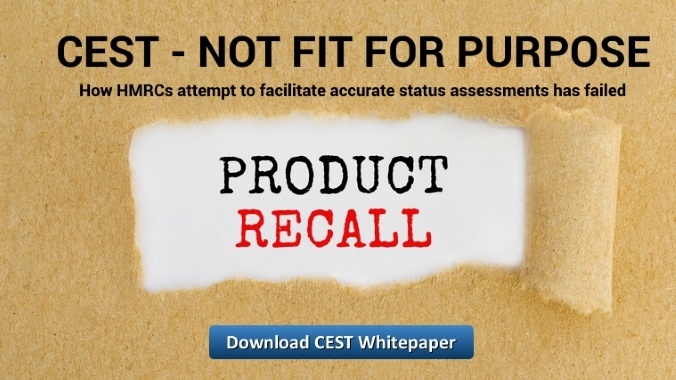HMRC’s Check Employment Status for Tax (CEST) tool does not fulfil the ‘reasonable care’ requirement set out within the Off-Payroll legislation, and so is unable to provide its users with any form of tax certainty.
This is the conclusion drawn by Philip Manley, former HMRC inspector and current tax partner at Dow Schofield Watts, in his contribution to ‘CEST: not fit for purpose’, a collaborative whitepaper with ContractorCalculator and The Law Place.
“Unless HMRC can disprove the substantial evidence demonstrating CEST’s shortcomings, then it’s clear that CEST is not fit for purpose,” Manley concludes, which is based on analysis of relevant case law, as well as HMRC’s own guidance.
Manley warns contractor clients and agencies that, as a result of CEST failing the reasonable care provision, its use offers no protections from the tax risk imposed by the Off-Payroll legislation. Unfortunately, many contractors using CEST in the private sector have already come to realise this, having had status assessments challenged by the taxman.
Has HMRC benefited from ‘reasonable care’ confusion?
A late amendment to the Off-Payroll legislation was the requirement that end-clients take ‘reasonable care’ when assessing the employment status of contractors. Included as Chapter 10, Section 61T(6)(c) of the Finance Act 2017, the clause moves the tax liability from the fee-payer to the client where the client has failed to exercise reasonable care in making an ‘inside IR35’ determination.
Although no definition has been provided in the legislation, the concepts of ‘reasonable care’ and ‘carelessness’ are well-trodden ground in case law, and are contained in section 29(4) of the Taxes Management Act (1970). HMRC regularly uses this to extend a tax payer’s investigation window up to a further six years by demonstrating that the tax payer has not exercised what is known as 'reasonable care'.
Manley’s conclusion is that CEST falls well short of meeting this requirement, meaning those who use CEST are at risk of backdated tax, penalties and interest if they are found to have made an incorrect assessment. Most worryingly of all, HMRC is already actively challenging CEST assessments.
What is reasonable care?
Manley examines the concept of reasonable care in cases such as Shakoor(TC2208) and Anderson (deceased) (TC206), commenting: “What we can draw from these cases is that if a taxpayer knows (or reasonably should know) that the position that they are declaring to HMRC is incorrect, then they have failed to take reasonable care.”
Manley also draws parallels between failure to take reasonable care and negligence, which is defined by Baron Alderman in Blyth v Birmingham Waterworks Co. (1856) as: “the omission to do something which a reasonable man, guided upon those considerations which ordinarily regulate the conduct of human affairs would do.”
However, Manley notes that the most conclusive evidence comes from HMRC’s own Compliance Handbook, which clearly summarises the taxman’s approach to reasonable care by providing numerous examples of what it considers ‘careless’. These include:
- ‘Recurrent errors in VAT Returns’; and
- ‘Systems are not accurate enough to produce correct figures for the return’.
Manley quotes the most telling remark from HMRC’s guidance (see HMRC, example 5): “A repeated inaccuracy may, depending on the specific systems failures, be seen as at least a lack of reasonable care.”
HMRC criticised for CEST promotion
“HMRC’s own guidance clearly states that when systems are not accurate enough to produce the correct outcome, HMRC would consider this at least a failure to take reasonable care,” he concludes.
“CEST fits well within this description, given its demonstrable inaccuracy and inconsistencies, which are now apparent to the wider public. Consequently, its use cannot be considered to be taking reasonable care.”
While Manley issues a warning to those considering using CEST, he also criticises HMRC for its promotion of the tool, which, as he highlights, contradicts its own morals:
“By insisting that use of CEST is mandatory, HMRC is itself effectively stating that reasonable care is no longer necessary. In which case, we once again arrive at a scenario where HMRC appears to be more intent on maximising revenues than ensuring the correct amount of tax is paid.”
What does this mean for agencies and hirers?
Under the legislation, the fee-payer – which will typically be the agency - is liable for the tax risk, as detailed in sections 61N(3) and 61N(4). However, there are two instances whereby the end client becomes the ‘fee-payer’, as set out in section 61T:
- Where an agency requests the reasoning behind a status decision and the client fails to respond within 31 days
- Where the client demonstrates that they have failed to take reasonable care when assessing a contractor.
According to Martyn Valentine, director of The Law Place, this means the agency could be free to overrule a client’s incorrect CEST assessment without assuming any tax risk:
“CEST evidently fails the reasonable care requirement. Where the agency has in writing that the end client used CEST, it can decide whether or not to disregard the decision and make its own reasoned decision regarding the contractor’s employment status, without worrying about the tax risk.”
Valentine adds that there is no legal requirement for the agency to inform the client that it is has decided to override the assessment, and advises agencies in the event of an HMRC investigation:
“Should HMRC investigate, the agency would need to share confirmation that the client made an assessment using CEST. Section 61T(6)(c) of the legislation would apply as a statement of legal fact. The agency could then inform HMRC that it decided IR35 did not apply and that the hirer failed to take reasonable care and consequently made an incorrect decision, relieving the agency of any liability.”


